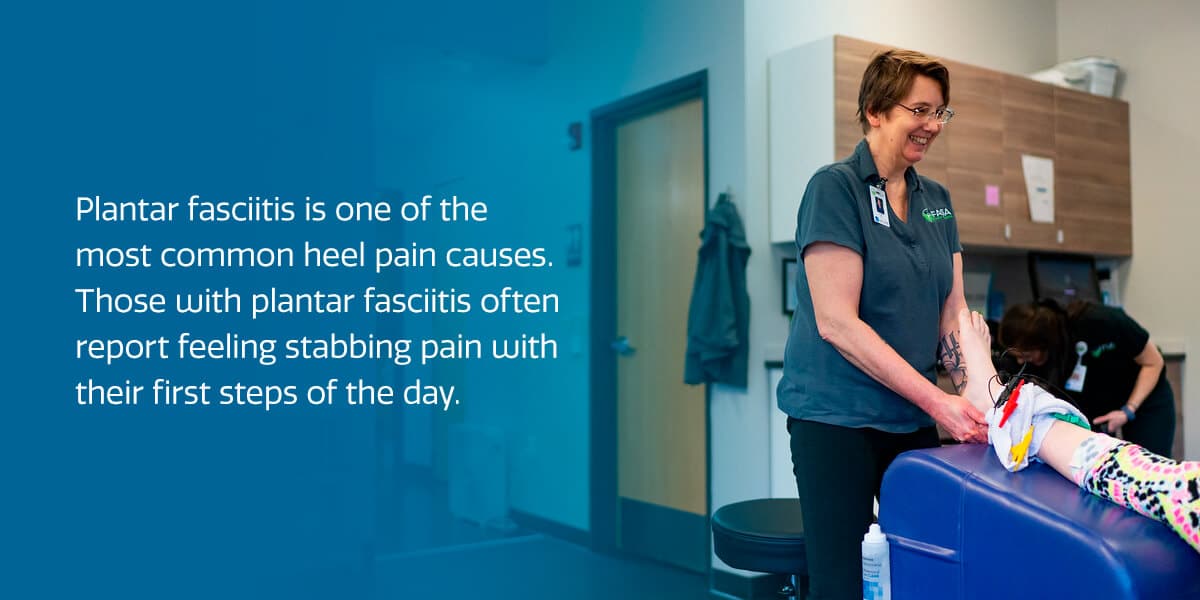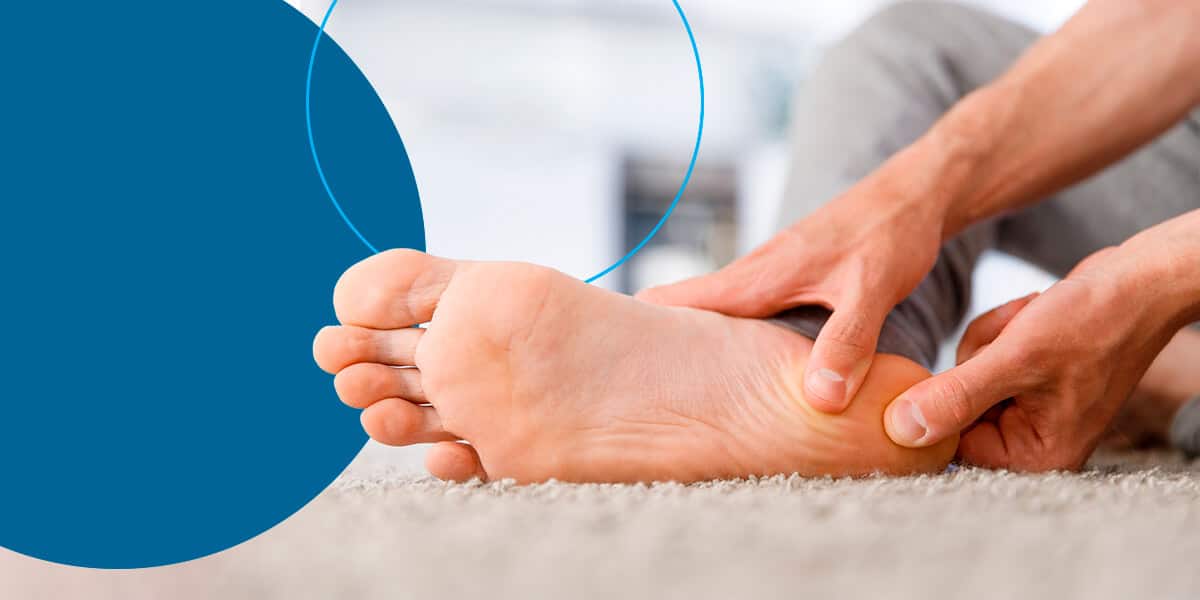Running is one of those activities that feels better the more you do it. At a certain point, running becomes an essential, non-negotiable part of your daily routine. So, when an injury like plantar fasciitis occurs and stops you in your tracks, it can feel like an unfair and frustrating setback. As plantar fasciitis is the most common injury among runners, it pays to know about this injury and what you can do to prevent it. Keep reading to learn more about running and plantar fasciitis.

What Is Plantar Fasciitis?
Put simply, plantar fasciitis is inflammation in your plantar fascia — the thick, fibrous tissue that forms the arch of your foot. As a ligament, your plantar connects your heel bone to the five metatarsal bones in your foot that link to the base of your toes. When the plantar fascia becomes inflamed, it commonly causes intense pain in your heel or foot arch.
Plantar fasciitis is one of the most common heel pain causes. Those with plantar fasciitis often report feeling stabbing pain with their first steps of the day. This pain usually subsides as you move throughout your day but may return after standing for long periods or standing up after sitting. The pain also tends to worsen after spending extended periods on your feet.
What Causes Plantar Fasciitis?
The plantar fascia supports the muscles in the arch of your foot. Through overuse and repetitive strain, the fascia tissue may stretch too much. When your plantar fascia is overstretched, tiny tears can occur on the ligament surface. The tears result in inflammation and pain in your heel and foot arch.
Various activities and risk factors can contribute to these tears in your plantar fascia. These risk factors include:
- Running, jogging or engaging in a sport that involves running
- Having flat feet or high arches
- Wearing high heels
- Occupations that involve standing for long hours at a time
- Wearing worn-out shoes with thin soles
- Obesity
What Is the Relationship Between Plantar Fasciitis and Running?
Running and plantar fasciitis are often interconnected, as runners commonly experience plantar fasciitis. If you experience pain while running in your heel or the sole of your foot, there’s a likely possibility you’re experiencing plantar fasciitis.
Does Running Cause Plantar Fasciitis?
While running is not the sole cause of plantar fasciitis, you can get plantar fasciitis from running. When you run, your plantar fascia absorbs much of the shock from contact with the ground or floor. Over time, this absorbed shock can cause tiny tears on the plantar fascia’s surface — usually near the heel bone.
Usually, plantar fasciitis pain occurs when you first start running and improves as you continue moving. The pain will likely return to some degree after you stop running.
Can You Get Plantar Fasciitis From Running Too Much?
The amount you run has less to do with getting plantar fasciitis than sudden changes to your running routine, improper form or abnormal foot structures. For example, plantar fasciitis commonly occurs in runners who suddenly increase the distance or intensity of their runs, exclusively run on hard surfaces or prefer running barefoot.
Frequent running can put you at increased risk of experiencing plantar fasciitis. Still, running with improperly fitted shoes or incorrect form is more likely to be the culprit of plantar fasciitis than a regular running routine. As such, paying attention to form, gear and technique with regular running routines is essential to avoid getting plantar fasciitis. Running with foot conditions like flat feet or high arches also increases your risk of plantar fasciitis.
Is It OK to Run With Plantar Fasciitis?
If you have mild to moderate plantar fasciitis, you may be able to continue with your running routine. Still, you’ll want to take several precautions to give the tissues time to heal and ensure your condition doesn’t worsen. Some precautions to consider may include:
- Using shoe inserts that support the arch of your foot and provide extra cushioning
- Wearing night splints while sleeping to keep the plantar fascia limber
- Thoroughly stretching the plantar fascia, Achilles tendon and calf muscles after running
- Warming up for five minutes before running to activate your ankle, foot and leg muscles
- Ice your plantar fascia for 10-15 minutes after running
If you’re experiencing increasing pain, consider taking a break from running until your symptoms improve. During this time, walking or aqua jogging may serve as low-impact alternatives so you can continue doing cardio exercises without worsening your condition.
How to Prevent Plantar Fasciitis if You Love to Run
Here are some tips to consider for preventing plantar fasciitis if you love to run:
- Wear proper shoes: Make sure your shoes are running-specific and fit correctly. If your shoes fit properly, there should be one-half-inch between your longest toes and the end of your shoe when standing with your weight evenly distributed on each foot. Running-specific shoes will provide sufficient arch support to help prevent plantar fasciitis from occurring.
- Make gradual changes to your routine: Since sudden changes in running habits often lead to plantar fasciitis, make sure you introduce changes gradually when increasing your duration, distance or intensity.
- Consider orthotics: If you have abnormal foot or gait dynamics like flat feet, high arches or overpronation, orthotic shoe inserts can provide the proper support to your foot and ankle to prevent plantar fasciitis. Consider custom orthotics from a podiatrist to ensure your orthotics support your foot and ankle properly.
- Warm up before running: Warmups are essential for any exercise to keep your muscles flexible and ensure they’re well supplied with oxygen. Since tight calf muscles are commonly associated with plantar fasciitis, it’s important that these muscles are limber before you run to prevent plantar fasciitis.
- Stretch after every run: For the same reason that warming up is necessary before running, stretching is essential after running to release the tension in your calf muscles, Achilles tendon and plantar fascia induced by running.
- Maintain a healthy weight: Since extra weight can put increased stress on the plantar fascia, it’s helpful to maintain a healthy weight to lower your risk of experiencing plantar fasciitis.
- Replace worn-out running shoes: Worn-out running shoes provide inadequate support to prevent plantar fasciitis. When you notice the soles losing tread or your shoes providing diminished ankle support, it’s time to replace them.
- Run on grass instead of concrete: Running exclusively on hard surfaces puts excess strain on the plantar fascia, so try to switch up your running locations. Grass transmits less shock to the plantar fascia than concrete or other hard surfaces.
For additional running tips, check out Dr. Lundborg’s Tips and Tricks for Running!
When to See a Doctor
If you’ve tried various at-home treatments like the rest, ice, compression and elevation (RICE) method or over-the-counter (OTC) orthotics without experiencing relief from your plantar fasciitis pain, it’s time to see a doctor. You should also seek medical attention for plantar fasciitis pain from running if you’re experiencing constant heel pain or can’t bear weight on your heel without pain.

Visit Foot & Ankle Surgical Associates for Plantar Fasciitis Care
At Foot & Ankle Associates, our podiatrists can provide the care you need for your plantar fasciitis to keep running or get back to the sport you love. For an appointment or more information about the link between running and plantar fasciitis, we welcome you to call us today at (360) 754-3338.





